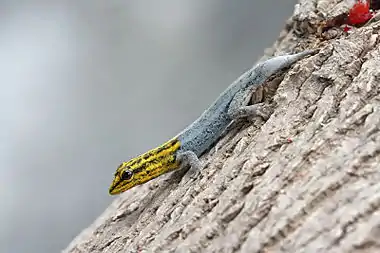| Yellow-headed dwarf gecko | |
|---|---|
 | |
| In Dar es Salaam, Tanzania | |
| Scientific classification | |
| Domain: | Eukaryota |
| Kingdom: | Animalia |
| Phylum: | Chordata |
| Class: | Reptilia |
| Order: | Squamata |
| Family: | Gekkonidae |
| Genus: | Lygodactylus |
| Species: | L. luteopicturatus |
| Binomial name | |
| Lygodactylus luteopicturatus Pasteur, 1964[1] | |
| Subspecies[2] | |
| |
The yellow-headed dwarf gecko or dwarf yellow-headed gecko (Lygodactylus luteopicturatus) is a small species of dwarf gecko found in the rocky areas of southern Kenya, Somalia (maybe as an introduced species), eastern Tanzania, and Zanzibar.[2] It can grow up to 90 millimetres (3.5 in), but on average attains a length of 80 millimetres (3.1 in) with a snout-vent (body) length of 39 millimetres (1.5 in). The tail length can be equal to the length of the body from snout to the anus (SVL or Snout-Vent Length).[3]
The yellow-headed dwarf gecko has a defense mechanism called tail autotomy, where they drop their tails to flee to safety when they are attacked by a predator. However, tail autotomy only gives the gecko an immediate benefit to escape because an autotomized gecko is slower without its tail and has difficulty running on vertical surfaces.[4]
References
- ↑ Pasteur, G. 1964. Recherches sur l'évolution des lygodactyles, lézards Afro-Malagaches actuels. Trav. Inst. Scient. Chérif., Ser. Zool., No. 29: 1-132
- 1 2 Lygodactylus luteopicturatus, The Reptile Database
- ↑ Geckos, Mohamed bin Zayed Species Conservation Fund
- ↑ Medger, Katarina; Verburgt, Luke; Bateman, Philip W. (2008). "The Influence of Tail Autotomy on the Escape Response of the Dwarf Gecko, Lygodactylus". Ethology. 114 (1): 42–52. doi:10.1111/j.1439-0310.2007.01445.x. hdl:2263/9021. ISSN 1439-0310.
- Broadley, D. G. & HOWELL, K. M. (1991). A checklist of the reptiles of Tanzania, with synoptic keys. Syntarsus, 1: 1—70
- Spawls, S.; Howell, K.; Drewes, R.C. & Ashe, J. (2001). A field guide to the reptiles of East Africa. Academic Press, 543 pp